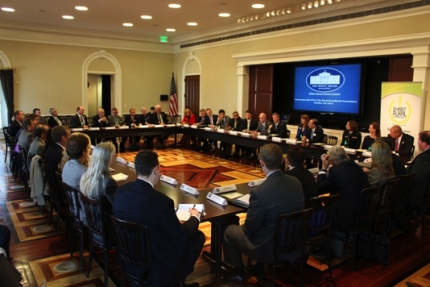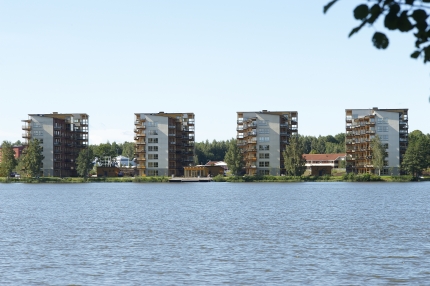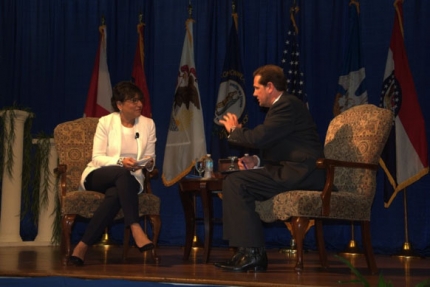White House Rural Council Blog
Promoting Rural Opportunity by Expanding Access to Broadband
Posted by on October 31, 2014 at 9:47 AM EDTPresident Obama has made expanding broadband access a key priority throughout his Administration. He launched the ConnectED Initiative in June 2013, ensuring that 99% of our students will have high-speed broadband in their classrooms by 2017 and that broadband infrastructure will reach rural areas. The White House Rural Council has supported these efforts to expand access to affordable broadband networks to support community benefits such as education, health care, and job creation.
Just this week, the White House Rural Council hosted a dialogue with members of the NTCA - The Rural Broadband Association. NTCA members are rural, independent, telecommunication companies from across America. NTCA advocates on behalf of these companies to ensure that they can drive innovation and deliver service throughout rural America. Our dialogue was focused on NTCA’s Smart Rural Community initiative, which recognizes a small selection of NTCA members who are exceptionally serving their communities by using their broadband systems to improve health care infrastructure, education, government services, among other needs.
Learn more about RuralWomen Are the Past, Present, and Future of American Agriculture
Posted by on October 17, 2014 at 2:20 PM EDTFrom historic homesteaders to contemporary cattle ranchers, women have been the cornerstone of America’s agriculture heritage. We’ve produced food to feed our families, feed our neighbors, and to feed the world.
The 2012 Census of Agriculture notes that nearly 1 million women are working America’s lands. That’s nearly a third of our nation’s farmers. These women are generating $12.9 billion in annual agricultural sales.
Farm work isn’t the only way women are contributing to agriculture. We are scientists, economists, foresters, veterinarians, and conservationists. We are in the boardrooms and the corner offices of international enterprises, and are the owners and operators of small businesses. We are property owners and managers. We are policymakers and standard bearers. Women are increasingly involved in every aspect of agriculture.
Learn more about RuralAnnouncing the U.S. Tall Wood Building Prize Competition to Innovate Building Construction
Posted by on October 10, 2014 at 10:46 AM EDTAs part of the Obama administration's commitment to mitigate climate change, USDA, in partnership with the Softwood Lumber Board and the Binational Softwood Lumber Council, is announcing the U.S. Tall Wood Building Prize Competition. This competitive prize, open to teams of architects, engineers, and developers, will showcase the architectural and commercial viability of advanced wood products like Cross Laminated Timber (CLT) in tall buildings.
Advanced wood products are becoming the latest innovation in tall building construction. Products like CLT are flexible, strong, and fire resistant. In construction, wood products can be used as a successful and sustainable alternative to concrete, masonry, and steel. Using wood also reduces greenhouse gas emissions by storing carbon and simultaneously offsetting emissions from conventional building materials. By some estimates, the near term use of CLT and other emerging wood technologies in buildings 7-15 stories could have the same emissions control affect as taking more than 2 million cars off the road for one year.
Learn more about RuralSentinel Landscapes: Where Conservation, Working Lands, and National Defense Interests Converge
Posted by on August 1, 2014 at 6:20 PM EDTLast July, the Administration launched the Sentinel Landscapes partnership to accomplish three critical goals: preserve agricultural lands, assist with military readiness, and restore and protect wildlife habitat.
In this unique collaboration, the U.S. Department of Agriculture, Department of Defense, and Department of the Interior work with state, local, and private partners to preserve and restore natural lands important to the nation’s defense mission. The basic premise is to preserve and restore habitat around the military base to ensure at-risk species can survive, while also improving military readiness by ensuring training activities can proceed unimpeded.
Joint Base Lewis McChord (JBLM), located in Washington state’s Puget Sound region, was the first designated Sentinel Landscape. Located about 10 miles southwest of Tacoma, Washington, JBLM is one of the premiere military installations on the West Coast, covering over 91,000 acres to support 43,000 soldiers and airmen for maneuver training and land-warrior system testing.
JBLM also boasts the largest and highest quality prairie habitat in the South Puget Sound region. Once covering more than 150,000 acres, this irreplaceable ecological asset now covers only 23,000 acres, with nearly 90 percent of it found on JBLM. This prairie landscape is a large part of the remaining habitat for several animal and plant species protected under the Endangered Species Act. As development moves closer, these species take refuge on the base, restricting certain military activities like maneuver training for Stryker Brigade Combat Teams. The Sentinel Landscapes partnership ensures that at-risk species can thrive in the habitat surrounding the base without threatening military readiness.
Learn more about Energy and EnvironmentSecond Made in Rural America Regional Forum Highlights Resources for Rural Delta Businesses
Posted by on July 25, 2014 at 7:29 PM EDTLast week, the White House Rural Council convened the second Made in Rural America Regional Forum to bring together local, state, and federal export-related resources for businesses and community leaders throughout the Mississippi River Delta Region.
The Delta Regional Authority and its state and local partners from Tennessee, Mississippi, and Arkansas hosted the forum at Southwest Tennessee Community College in Northeast Memphis. The Delta region, with its entrepreneurial history, available land, and accessible waterways and transportation network, is primed to reap the benefits of increased exports and participation in exporting.
More than 240 small business owners, industry representatives, community lenders, economic development officials, and community leaders attended the day-long forum. The forum offered business-to-business advice and best practices on expanding into international markets, highlighted financing resources, and facilitated discussion among regional leaders about how to incorporate exports into long-term economic development strategies.
Learn more about RuralLocal Food, Local Places: A Federal Partnership to Help Rural America Use Local Food and Build Local Economies
Posted by on June 9, 2014 at 12:30 PM EDT
Today, the White House Rural Council Chairman USDA Secretary Tom Vilsack announced Local Food, Local Places, a federal initiative providing direct technical support to rural communities to help them build strong local food systems as part of their community’s economic action plans. Under this effort, a team of agricultural, transportation, environmental, and regional economic experts will work directly with local communities to develop comprehensive strategies that use local food systems to meet a variety of needs.
The announcement, made during the White House Rural Council’s first live-streamed meeting, included Vilsack, U.S. Transportation Secretary Anthony Foxx, Environmental Protection Agency Deputy Administrator Bob Perciasepe, Appalachian Regional Commission Federal Co-Chairman Earl Gohl, and Delta Regional Authority Federal Co-Chairman Chris Masingill.
Learn more about Rural
- &lsaquo previous
- 1
- 2
- 3
- 4
- 5
- 6
- 7
- 8
- 9
- …
- next &rsaquo
White House Blogs
- The White House Blog
- Middle Class Task Force
- Council of Economic Advisers
- Council on Environmental Quality
- Council on Women and Girls
- Office of Intergovernmental Affairs
- Office of Management and Budget
- Office of Public Engagement
- Office of Science & Tech Policy
- Office of Urban Affairs
- Open Government
- Faith and Neighborhood Partnerships
- Social Innovation and Civic Participation
- US Trade Representative
- Office National Drug Control Policy
categories
- AIDS Policy
- Alaska
- Blueprint for an America Built to Last
- Budget
- Civil Rights
- Defense
- Disabilities
- Economy
- Education
- Energy and Environment
- Equal Pay
- Ethics
- Faith Based
- Fiscal Responsibility
- Foreign Policy
- Grab Bag
- Health Care
- Homeland Security
- Immigration
- Innovation Fellows
- Inside the White House
- Middle Class Security
- Open Government
- Poverty
- Rural
- Seniors and Social Security
- Service
- Social Innovation
- State of the Union
- Taxes
- Technology
- Urban Policy
- Veterans
- Violence Prevention
- White House Internships
- Women
- Working Families
- Additional Issues




